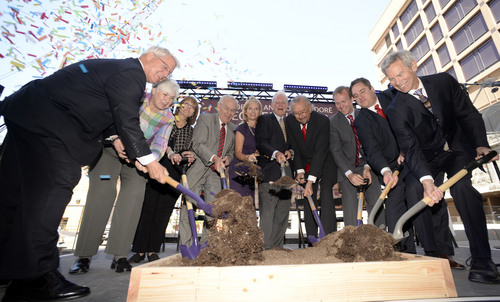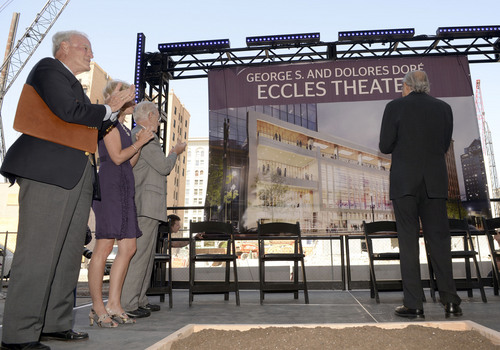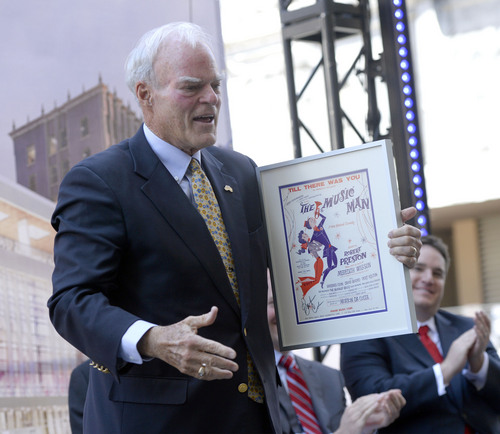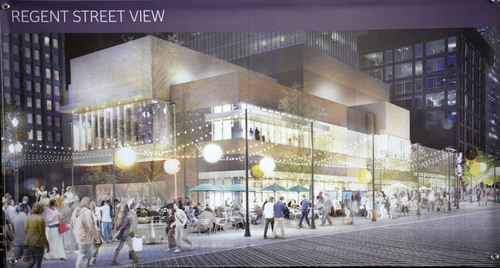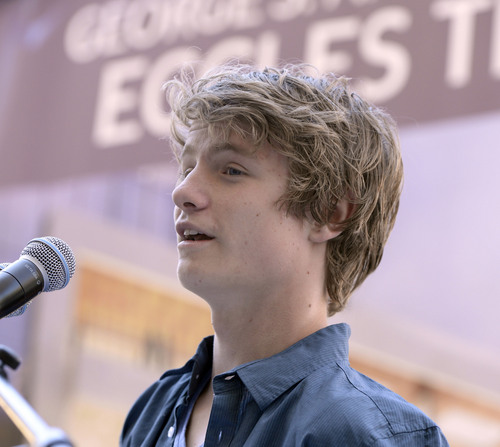This is an archived article that was published on sltrib.com in 2014, and information in the article may be outdated. It is provided only for personal research purposes and may not be reprinted.
The percussion of a brass band over a background din of ongoing demolition set the stage for a casting change Tuesday at the Utah Performing Arts Center — even before the Salt Lake City theater has been built.
It now will be called the George S. and Dolores Doré Eccles Theater, thanks to a $15 million donation from the Eccles Foundation.
Private donations will cover 10 percent to 18 percent of the overall price tag of the building, which is currently pegged at between $110 million and $117 million.
Spencer Eccles, on behalf of the foundation, said the contribution adheres to the core beliefs of the Eccles family in valuing the arts in the Salt Lake City area. "It's our hope that when you see the marquee of the George and Dolores Eccles Theater, it will mean more to you than just a name or a recognition of a single gift."
Salt Lake City Mayor Ralph Becker and Salt Lake County Mayor Ben McAdams headed up Tuesday's groundbreaking ceremony for the 2,500-seat theater, designed to suit traveling Broadway shows. The theater will also have a black box venue, with 200 seats, for experimental performances.
"It may take some imagination to envision the new performing arts center," Becker said. "[But] in no time at all, we will see this amazing building start to take shape."
He also announced a "generous," though unspecified, donation from Delta Air Lines. The main performance hall will be named after the air carrier for its contribution.
The project previously received a $2 million donation from the Larry H. and Gail Miller Family Foundation and early support from The Church of Jesus Christ of Latter-day Saints, said Helen Langan, Becker's communications director.
The playhouse budget outlines $27 million in such private donations.
Officials said Tuesday that more naming-rights opportunities would be coming later for the facility.
The largest chunk of funding, however, will come from property taxes earmarked to retire the debt on the EnergySolutions Arena and the Salt Palace expansion. Langan said the funds were intended for downtown development and will constitute the main source of revenue for the project. Those funds will become available in 2016 and could cover about 70 percent of the construction costs and interest on the theater.
Langan said because the city is "redirecting the resource," taxes would not increase to fund the facility.
Much of the demolition for the multifaceted facility planned for Main Street between 100 South and 200 South is complete. Tuesday's groundbreaking marked the official beginning of new construction as dignitaries plunged nine shovels ceremonially into the dirt. The performing arts center is scheduled to open in spring 2016.
Becker said the theater has been a "labor of love" for more years in planning than it will take in time to construct. Layton Construction is the lead contractor.
The playhouse was designed by HKS Architects and the renowned designer Cesar Pelli of New Haven, Conn.-based Pelli Clarke Pelli. Pelli said he designed the theater so that every seat will be a "fantastic" seat with a prime view of the performances.
"It's clearly a contemporary building that represents the best and brightest ideas of our time," Pelli said when the design was unveiled last year. "Iconic architecture doesn't have to be overbearing."
The building will boast a lighted facade with windows and white paneling. It overlooks Main Street and the downtown TRAX line.
Pelli hopes the theater will be a city showcase for decades to come. "A theater has to be an iconic structure. It is a special place where people go to forget everyday life," he said. "It could affect them for a few days or an entire lifetime."
Eccles hopes the public will think not only about the future of the new theater, but also the past it represents. He said the new facility is an extension of Utah's history that began with Brigham Young.
"Here, in the state, the arts are deeply woven into the fabric of our lives," he said. "We value them, we appreciate them, we celebrate them."



